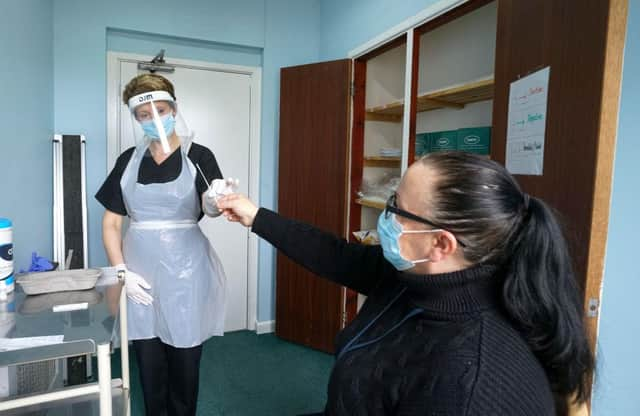Care homes have been ‘failed’ by test rollout claim researchers


Care homes in England are being “failed” by a flawed rollout of rapid-result tests, an expert has warned as analysis of a pilot found “poor” adherence and no impact on outbreaks.
The majority of staff in 11 Liverpool care homes carried out less than a third of the rapid-result lateral flow device (LFD) tests required over six weeks between December and January, according to a pre-print paper.
Advertisement
Hide AdAdvertisement
Hide AdResearchers from the universities of Liverpool, Nottingham and Imperial College London found no significant difference in the proportion of care homes with outbreaks or the size of outbreaks when comparing the results with homes that were not participating in the pilot.
‘Excessive work burden’
Factors linked to poor adherence included testing requirements adding to an already “excessive” work burden, being required to return to the workplace during time off for tests, concerns around accuracy and the implications it could have on income and workload.
The authors warn that a failure to address these factors means use of the tests will not prevent outbreaks and the associated pressures on staff could lead to increased turnover and burnout.
Lateral flow tests do not need laboratory assessment and can give results in fewer than 30 minutes.
Advertisement
Hide AdAdvertisement
Hide AdExperts have said they are effective at finding people who are most infectious and most likely to transmit the virus to others.
Currently care home staff in England are required to take two LFD tests and one lab-assessed PCR test a week.
As part of the pilot, staff were required to take twice weekly Innova LFD tests at their workplace.
Despite an initial “eagerness to participate”, just 8.6% of staff took and logged more than 75% of the required tests, and around a quarter took and logged more than half of the tests.
Advertisement
Hide AdAdvertisement
Hide AdCoronavirus outbreaks were identified in six of the homes within 10 days of the study period – in only one was a positive LFD result identified beforehand.
‘Disconnect’ between prescribed testing regime and its real-life context
The authors say there is a “disconnect” between the prescribed testing regime and its real-life context, which “risks an increase in staff dissatisfaction and its attendant potential for increased staff turnover and burnout” if not addressed.
They write: “Without addressing the contextual and human factors that lead to poor adherence of testing protocols, these testing regimes will not have the opportunity to perform at the required level to prevent outbreaks in care homes.”
Advertisement
Hide AdAdvertisement
Hide AdDr Peter Buckle, principal research fellow at Imperial College London and study author, said the LFD rollout appears to have taken place without being “fully thought through” or with enough consultation with care homes.
He told the PA news agency: “This, to us, has not only failed the care homes, but probably created some long-term trust issues, I would have thought… between care homes generally and what’s being advocated centrally, because it clearly has caused them a lot of concerns and worries and hasn’t protected them in the way that they might have believed it would.”
Prof Buckle warned against “misplaced confidence” in the testing system, adding that he has no reason to think the pilot findings are not reflected elsewhere.
He said there is a window of opportunity of several months to learn from care homes about what is working and make sure an effective testing system is in place before any third wave.
Advertisement
Hide AdAdvertisement
Hide AdHe added: “I think the need to carry on having very robust testing is going to be with us for a very long time.
“And I think we have a duty of care to make sure that that testing is optimum.
“Our research suggests that there are lots of problems with the existing testing system that need to be resolved quickly.”
DHSC: ‘We remain committed to the use of these rapid lateral flow devices in care homes’
Advertisement
Hide AdAdvertisement
Hide AdPart of the evaluation included interviews with 15 staff members from nine care homes.
They explained that the requirement for frequent staff testing was incompatible with employees’ work schedule.
There were also concerns around the accuracy of the LFDs and the implications of results on staff income and workload.
And the authors said pandemic-related work stressors, such as exhaustion due to an increased workload and feeling demoralised due to a lack of public recognition, is a factor in accepting additional workplace burdens.
Advertisement
Hide AdAdvertisement
Hide AdLiz Jones, policy director at the National Care Forum, said the research highlights “really key points” for the shaping of longer-term surveillance measures in care homes.
She said: “It illustrates the reality of the current testing regime in terms of time, complexity and cost, as well as the challenges of making it work with variable shift patterns, staff rotas, training and space to conduct testing.
“It also recognises the ‘opportunity cost’ of the current design of the testing regime – so the time used on testing cannot be devoted to care.”
A Department of Health and Social Care spokesperson said: “Around one in three people do not show any symptoms of infection and, as we navigate the road map out of the pandemic, rapid lateral flow devices and PCR tests are vital weapons in our arsenal, detecting under the radar cases and helping to keep our most vulnerable safe.
Advertisement
Hide AdAdvertisement
Hide Ad“The testing regime for care home staff uses both LFD and PCR, which combines the rapid results of LFD testing, with the higher sensitivity of PCR tests.
“We remain committed to the use of these rapid lateral flow devices in care homes, and we are in touch with care homes with lower-take up rates to provide additional support.”
Reporting by Press Association